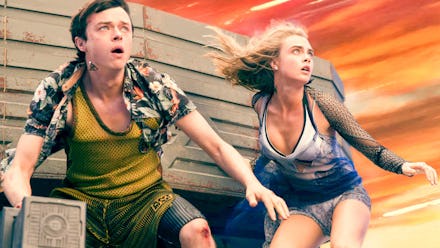‘Valerian and the City of a Thousand Planets’ isn’t that bad. Really.

The opening scene of Valerian and the City of a Thousand Planets, an intergalactic space romp set in the 28th century, takes place much closer to the present. It’s 1975, presumably on the International Space Station, as Russian and American astronauts exchange a formal yet peaceful handshake set to David Bowie’s “Space Oddity.” We see this process played out over years, then decades and, finally, centuries. In that time, the handshakes segue from human to human to alien to human. Much like different cultures on Earth, not everyone initially perceives the handshake for what it is: a symbol of good faith. But ultimately, every alien extends their hand — or whatever’s the closest equivalent to one — as a gesture of goodwill.
That’s how Alpha, the moving, thriving metropolis and titular “City of a Thousand Planets” is formed. It underscores the hopeful message, one that can certainly be applied to us back on Earth, from director Luc Besson: Great things happen when we embrace other cultures and the unknown with empathy. It’s a strong, guiding principle, but the real draw of Valerian is the sumptuous effects and visual style. The myriad aliens that call Alpha home hit all ends of the spectrum: creepy, alluring, regal, even shape-shifting, all gorgeously realized on-screen. (Not all films are necessary 3-D viewing, but if there’s one summer film that benefits from the format, it’s Valerian.)
A kaleidoscope of color, species and orgasmic special effects make Valerian one of the most visually arresting films since Avatar sent us to picturesque Pandora eight years ago. Unfortunately, Valerian suffers from the same pitfalls as James Cameron’s sci-fi epic. When you take a second to collect yourself and mop up the excess drool that’s formed on your lap, you realize you’re watching a film with a paper-thin plot and, outside of the work from Cara Delevingne, uninspired performances.
It’s certainly not winning everyone over; the Hollywood Reporter considers it an early Razzies frontrunner, and a poor box-office showing could deal a major financial blow to Besson’s EuropaCorp. But even with these shortcomings, chances are you’ll be so entranced you won’t think too much about the weaknesses until the credits roll.
At the center of the film is the titular character, Valerian (Dane DeHaan), and his partner — both professionally and romantically — Laureline (Delevingne). They’re both government operatives tasked with keeping the peace in human territories across the universe. Their latest mission eventually takes them to Alpha, where an unknown and unseen force threatens to wipe out everything on the station. That’s the gist of it, and saying anything further about the machinations on Alpha would likely spoil the film’s contrived attempt at a twist.
And, let’s be honest, if you’ve seen any of the trailers for Valerian, you’re probably here for the visuals anyway. Besson’s work has been defined by its stunning aesthetics, ever since The Fifth Element shot us into deep space in the late ’90s. The Fifth Element was an impressive feat, with 188 special effect shots making it the most expensive French-financed film at the time — but to get an idea of how far film technology has come in the decades since, Valerian has 2,734 special effects shots.
There isn’t any one particular planet or alien species that stands out — though a shape-shifting alien played by Rihanna will certainly catch your eye — you’ll likely be more awestruck by the entirety of the film’s fantastical, vividly colored vision. But if there is a moment that rises above the rest, it’s when Valerian is in hot pursuit of a threat and Laureline maps out a shortcut that sends him barreling through various habitats on Alpha. He traverses through expansive skyscrapers, a bustling city center, vast underwater terrain, amorphous, squishy blue blobs in a gaseous quadrant of Alpha (I’m trying my best here) and, briefly, the openness of space. It really is a breathtaking sequence.
Avatar’s Pandora had a very similar effect, but that film focuses on one planet and largely one species (plus a few stray creatures). With Valerian, Besson has constructed more than just one world; he’s presenting a galaxy’s worth of imagination on the screen.
That makes it all the more disappointing the cast can’t match even a modicum of Besson’s creative passion in their performances — sans Delevingne, who gives a serviceable and charismatic take on Laureline, one of sci-fi’s pioneering feminist icons. DeHaan, in particular, is monotonous and lacks any semblance of charm, which is especially problematic since the movie’s named after his character. It doesn’t help Valerian isn’t particularly likable, either. One recurring plot point in his romance with Laureline is his “playlist,” a collection of his previous conquests — or, in other words, women he’s slept with. Behold, the 28th-century male.
But in a blockbuster season riddled with sequels, remakes and reboots, Valerian is a welcome respite, the first onscreen incarnation of a French comic series most people outside of Europe aren’t likely to recognize. It doesn’t hit the highs of Wonder Woman or Spider-Man: Homecoming, but both of those are part of larger, more established cinematic universes. That Valerian will compete at the box office with Christopher Nolan’s Dunkirk, another big-budget blockbuster that isn’t tied to some multiphase film rollout, is a cruel twist of fate.
I hope the poor scheduling and handful of negative reviews doesn’t hurt Valerian, which has all the makings of the first entry in a new intergalactic franchise. It’s a visual triumph unlike anything I’ve ever seen, setting a new benchmark Avatar once established. Surely we didn’t visit all 1,000 planets already?
Valerian and the City of a Thousand Planets arrives in theaters July 21.